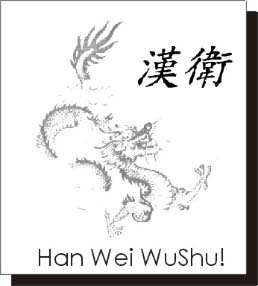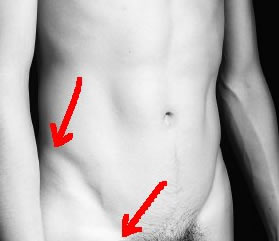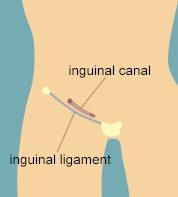Natural Traditional Chinese Martial Arts articles by Sal Canzonieri
This was my second column in Han Wei Wushu, it is about maximizing efficiency and effectiveness in a Traditional Chinese martial arts system.

(May 1995 issue #13)
Article #2
Traditional Chinese Martial Arts Essentials...
Maximing Your Efficiency & Effectiveness In Traditional Chinese Martial Arts Wushu Kungfu
========================================================
By Salvatore Canzonieri, New Jersey
To go beyond the mere repetition of traditional form routines to create a martial art that really works for self defense, there are certain aspects of traditional natural body mechanics training that must be incorporated in order to make one's
techniques more efficient and effective. Traditional Chinese Wushu techniques that are executed with efficiency (the economic and timely execution of movement) and with effectiveness (the practical and successful execution of movement) make the difference
between practicing an impressive traditional martial art or performing an empty dance ritual devoid of substance. In this way, one can enjoy the benefits of almost 5,000 years worth of Chinese martial arts experience.
The proper use of body mechanics (as performed in conditioning exercises, stepping patterns, stances, punching/ kicking/ grappling /trapping/ chin-na techniques, and qigong methods) is meant to be practiced for making the movements in
one's forms executable with maximum efficiency and effectiveness. The result is that one's techniques are smooth, graceful, deeply
rooted, powerful, skillful, free flowing, health enduring, energy producing, and dynamic. Thus, this training produces martial
artists whose techniques are both practical and economical in execution while being devastating in effect.
 One of the most important points in proper body mechanics is the opening and closing of the "Kua" or "Inguinal Fold". The Kua is the Chinese name
for the area of the body where the most power can be generated (once one has the proper alignment of the bones, muscles,
tendons, ligaments, and breath). This area contains the deep muscles of the hips and waist. The kua area extends from the
inguinal ligament through the inside of the pelvis to the top crest point of the hip. The kua thus includes the right and left
energy channels (used in qigong practice); the pelvis and hip joint; the sacrum and lower lumbar vertebrae of the spine; the
iliopsoas muscle grouping that connects the spine to the lower hips and femur leg bones; the adduction muscles that connect the
lower pelvis to the length of the femur; the pelvis diaphragms, which aid in breathing; the small intestines containing the lower
dantian point; and the lower bowels, containing the perineum point.
One of the most important points in proper body mechanics is the opening and closing of the "Kua" or "Inguinal Fold". The Kua is the Chinese name
for the area of the body where the most power can be generated (once one has the proper alignment of the bones, muscles,
tendons, ligaments, and breath). This area contains the deep muscles of the hips and waist. The kua area extends from the
inguinal ligament through the inside of the pelvis to the top crest point of the hip. The kua thus includes the right and left
energy channels (used in qigong practice); the pelvis and hip joint; the sacrum and lower lumbar vertebrae of the spine; the
iliopsoas muscle grouping that connects the spine to the lower hips and femur leg bones; the adduction muscles that connect the
lower pelvis to the length of the femur; the pelvis diaphragms, which aid in breathing; the small intestines containing the lower
dantian point; and the lower bowels, containing the perineum point.
 The inguinal groove inside the pelvis contains the largest amount of lymph nodes in the body (next comes the arm pit area).
Since lymph is moved by muscular contractions, every time one walks or moves the legs (and arms) the lymph nodes are activated.
Exercising the kua area strenghtens the immune system and that is how Taiji, Chi and Neigong, and other internal practices are able to
provide health enhancing effects. Without the kua functioning properly, one would not be able to sit down or stand up, or even to walk erect. By being conscious of the kua, one is
able to have proper alignment of the body's joints, muscles, and bones.
The inguinal groove inside the pelvis contains the largest amount of lymph nodes in the body (next comes the arm pit area).
Since lymph is moved by muscular contractions, every time one walks or moves the legs (and arms) the lymph nodes are activated.
Exercising the kua area strenghtens the immune system and that is how Taiji, Chi and Neigong, and other internal practices are able to
provide health enhancing effects. Without the kua functioning properly, one would not be able to sit down or stand up, or even to walk erect. By being conscious of the kua, one is
able to have proper alignment of the body's joints, muscles, and bones.
It follows then that the Hips (Iliac Crest) should always move as a natural consequence of actions initiated in the legs. Since the hips have no mechanism by which to move in and of themselves, it is incorrect to think that we move from our hips. The hip are 'caused' to move. The hips must 'allow' movement. They must acquiesce to pressure, letting force, movement, and energy transfer up, down, forward, backward and side to side. While the pressure may come from the opposite leg's driving force, the hips themselves must remain loose, receptive, passive and clear. We do not try to move the hips in relation to force but, like the axle of a wheel, allow them to rotate as a matter of course. Usually it is the passive rotation 'into' one hip which causes the passive rotation out of the other hip. This is often described as 'folding' the hip or kua.
The weight should be borne by the kua, not the knee when doing forms or movements. The knee is a weight transference joint, not a weight bearing joint. The line from the knee to the ankle in the weight bearing leg must be stable and at a 90 degree angle to the floor. Alignment should be such that pressure goes directly into the center of the arch of the foot. No pressure should be in the knees or else they will be damaged over time. The knee should not be collapsed innerward, forward, or outward.
Once the proper alignment is achieved, one lowers down by squeezing the kua closed and rises up by pushing or expanding the
kua upwards. The opening and closing of the kua should occur whenever one is stepping or moving from stance to stance.
Thereby, one lowers the body's root (becoming more stable) and a powerful springiness occurs since the knees are not bearing weight
but transferring it. In executing the movements of a form, one continually contracts and expands the kua to generate great power
and elasticity. A coiling effect occurs that travels up the legs, through the spine, over the shoulder, and out the arm. Strikes
become much more powerful when the kua is used during movement. Movement becomes firmly generated from the feet to the legs to the waist, coordinating
the whole body in a strike.
When striking from a rooted stance, the closing/opening kua allows power to come up and out, putting the whole body weight
behind the strike as powerful hip muscles do their work. When moving from side to side (as in stepping from right to left bow
stance or from bow to horse, etc.) the opening/closing kua allows greater and more powerful rotation of the waist, which also
generates powerful strikes.
The feet counterbalance the rotation of the waist by turning as one steps. As the kua closes on the side no longer bearing the
weight, the heel stays planted and the toes turn in toward the center of the body. Then on the side bearing the weight, the kua
opens, the heel stays planted and the toes turn away from the center of the body. This movement is done when stepping from bow
stance to bow stance; the opposite happens from horse stance to bow stance. This situation is because the leg bearing the weight
moves first to maintain the deep root. Once the feet are rooted, the rear leg can generate force and transmit counterforce back
into the ground.
Next, the waist's movements direct the force that is being emitted from the legs and the opening/closing of the kua. The
spine must be aligned erect from the waist to have correct posture and the pelvis is shifted forward. This makes the
tailbone tilt down and the organs can rest in the pelvis and breathing is more relaxed and free, giving room for the diaphragm
to be used for breathing. The spine is straightened in this way and is able to channel energy up its length and out the arms.
The waist steers the direction a strike comes from and where a neutralizing technique goes to. The waist must be relaxed and
as one moves, the waist should not go up and down; the height level is maintained to keep a deeply rooted stance. This allows a
firm flow of energy and power when moving, which is called generating 'jing'.
Instead of the muscles of the arms and shoulders being the source of energy, by generating jing through proper body
mechanics, the waist, legs, and belly area (dantian) are the source. This type of whole body movement makes it easier to
remain in firm contact with the ground and staying rooted, keeping one's center and source of motion from being upset by an opponent.
The body generates more energy as it flows more freely through a relaxed and properly aligned body. One can more easily
then direct the body through the will because one can concentrate on the actions that need to be done rather than the discomfort
and pain that an unrelaxed body feels. Muscular strength increases automatically as more exertion is allowed. With more energy
flowing through them, the muscles are given a surge of power. Flexibility and elasticity of the muscles increases making them
feel more inflated. They thus become more capable of resisting a strike or generating a lot of power to strike. This increase of
concentrated energy makes one's movements more effective, since they would be stronger.
Efficiency is also increased because one can generate the same power with less muscle tissue than before. With relaxed
muscles, the energy flow increases and speed increases. Since the tendons are now aiding the muscles, one can do more with them.
As the force generated through the opening and closing of the kua and the legs being in alignment is bounced up from the ground, it
is coiled through the body, and transmitted through the joints. A burst of energy moves swiftly in a free flowing manner is it
connects from joint to joint through the now tensionless muscles. As the bones support the strike, they are moved with faster and
stronger body tissue causing a devastating strike.
A firm but relaxed state during movement using proper body mechanics allows powerful energy to coil and snap out like a whip
at the point of striking because the whole body is working in unison and is not fighting against itself. The sudden expansion
and contraction develops great speed and power. In this way, by using the tendons of the joints as well as the bones and muscles,
body movements are economical and practical and oneþs martial art becomes efficient in its execution and effective in its results.
An external style that also circulates this energy up the spine and into the arms is greatly improved, in that it would
have all the benefits of the internal styles as well as its own techniques.
Without proper body mechanics and the generation of jing, martial art forms are only empty dance, useless for self defense
applications and the generating of health and vitality. With the proper body mechanics (alignment of joints, closing/opening of
the kua, stepping patterns, waist movement, deep root), each time one executes a form, he/she will be at the same time building up
their health. This is true for both internal (i.e., taiji, baqua) and external (i.e., shaolin, hung gar, etc.) martial
arts.
* Salvatore Canzonieri is a freelance artist & writer for various publications (Wushu Kungfu, Han Wei's Wushu, Seconds, EXIT, and
others), with experience in Taiji, Southern Shaolin, Northern Shaolin, Qigong and various other Traditional Chinese
Kungfu styles. He is currently researching material for a future Encyclopedia of Traditional Chinese Kungfu History and Forms *
That's it for this issue! Click here to read article #3
Sal Canzonieri - http://www.bgtent.com/CMAQigongSchool/index.html
salcanzonieri@att.net